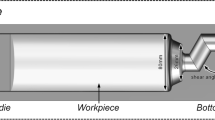Abstract
As a new type of plastic-forming technology, rotary extrusion has the advantages of increasing the hydrostatic stress inside the deformed body and obtaining severe plastic deformation, which creates favorable mechanical conditions for repairing cavity defects. In this article, Deform-3D finite element software is used to establish the finite element model of cavity closure during rotary extrusion and analyze the cavity closure process. The influence of extrusion speed and rotation speed on the evolution of spherical cavity defects was studied, and the critical condition of cavity closure in magnesium alloy during rotary extrusion was obtained. Based on Z-C model and numerical simulation, the adaptability of the model under different parameters was analyzed, and a spherical cavity evolution model suitable for AZ80 magnesium alloy rotary extrusion was constructed to predict the change of cavity closure volume. The physical experiment of cavity closure in rotary extrusion was carried out on a Gleeble-3500 thermal simulator, which verified the accuracy of the numerical simulation and cavity evolution model and provided theoretical guidance for improving the performance of rotary extrusion products and related research.










Similar content being viewed by others

References
E. Mark, B. Aiden, B. Matthew, D. Chris and D. Gordon, JOM J. Miner., Metals Mater. Soc. 60(11), 57 (2008).
D.H. Qin, M.J. Wang, C.Y. Sun, Z.X. Su, L.Y. Qian and Z.H. Sun, Mater. Sci. Eng., A 788, 139537 (2020).
Y. Jianmin, Z. Zhang, X. Ping, Y. Meng, M. Meng, B. Dong and H. Liu, Mater. Lett. 265(15), 127384 (2020).
M.S. Chen, and Y.C. Lin, Int. J. Plast 49, 53–70 (2013).
X.-X. Zhang, Z.-S. Cui, W. Chen, and Y. Li, J. Mater. Process. Technol. 209(4), 1950 (2009).
Y.S. Lee, S.U. Lee, C.J. Van Tyne, B.D. Joo, and Y.H. Moon, J. Mater. Process. Technol. 211(6), 1136 (2011).
H. Kakimoto, T. Arikawa, Y. Takahashi, T. Tanaka, and Y. Imaida, J. Mater. Process. Technol. 210(3), 415 (2010).
F. Faini, A. Attanasio, and E. Ceretti, J. Mater. Process. Technol. 259, 235 (2018).
Y.D. Kim, J.R. Cho, and W.B. Bae, J. Mater. Process. Technol. 211(6), 1005 (2011).
M.C. Clintock and A. Frank, J. Appl. Mech. 35, 363 (1968).
S.H. Zhang, X.R. Jiang, Z.X. Xia, Q.Y. Zhang, W.H. Tian and Y.X. Li, Mechan. Mater. 145, 103373 (2020).
J.R. Rice, and D.M. Tracey, J. Mech. Phys. Solids. 17(3), 201 (1969).
L. Gurson Arthur, J. Eng. Mater. Technol. 99(1), 2–15 (1977).
B. Budiansky, J.W. Hutchinson, and S. Slutsky, Mech. Solids Rodney Hill Ann. 13, 45 (1982).
V. Tvergaard, J. Mech. Phys. Solids. 32(5), 373 (1984).
N. Harris, D. Shahriari, and M. Jahazi, J. Manuf. Process. 26, 131–141 (2017).
H.T. Zhou, Q.B. Li, Z.K. Zhao, Z.C. Liu, S.F. Wen, and Q.D. Wang, Mater. Sci. Eng., A 527(7–8), 2022–2026 (2010).
Acknowledgements
This research was financially supported by the Shanxi Scholarship Council of China (2021-127).
Author information
Authors and Affiliations
Corresponding author
Ethics declarations
Conflict of interest
The authors declare that they have no known competing financial interests or personal relationships that could have appeared to influence the work reported in this paper.
Additional information
Publisher's Note
Springer Nature remains neutral with regard to jurisdictional claims in published maps and institutional affiliations.
Supplementary Information
Below is the link to the electronic supplementary material.
Rights and permissions
Springer Nature or its licensor (e.g. a society or other partner) holds exclusive rights to this article under a publishing agreement with the author(s) or other rightsholder(s); author self-archiving of the accepted manuscript version of this article is solely governed by the terms of such publishing agreement and applicable law.
About this article
Cite this article
Li, X., Wang, Q., Fang, Q. et al. Study on Cavity Evolution of AZ80 Magnesium Alloy During Rotary Extrusion. JOM 75, 470–477 (2023). https://doi.org/10.1007/s11837-022-05583-8
Received:
Accepted:
Published:
Issue Date:
DOI: https://doi.org/10.1007/s11837-022-05583-8


